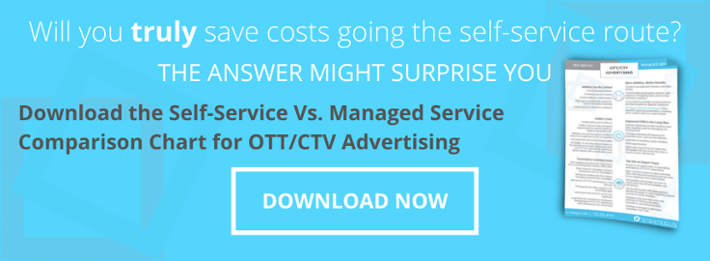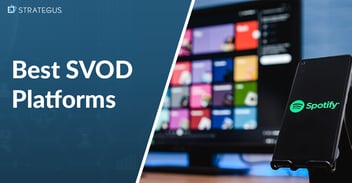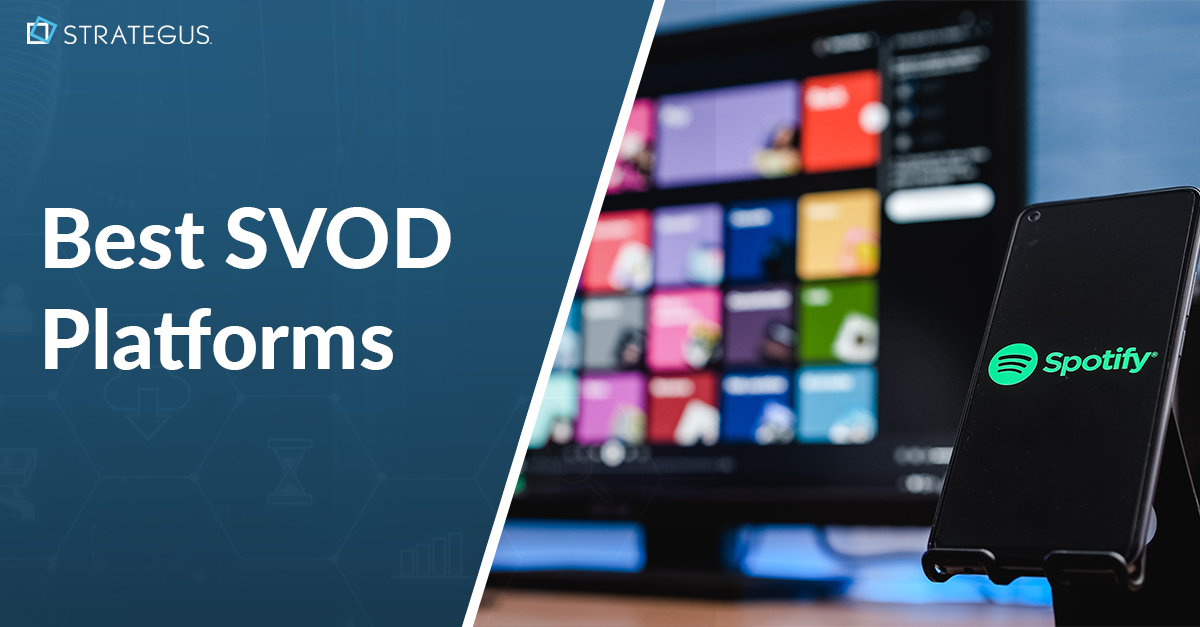- Home
- Strategus Blog
- The All-In-One Guide to Programmatic Ad Buying
The All-In-One Guide to Programmatic Ad Buying
 Andy Dixon
Andy Dixon
10 minutes read

With the advent of automated buying methods and evolving landscape of streaming, media buying is entering uncharted territory. The days of manual media buying are becoming obsolete, and if you want to remain competitive in the media buying space, it’s crucial to adapt to programmatic ad buying.
However, doing something entirely new is far from simple, especially for traditional media buyers who are accustomed to the old way of operations. From updated technology to unfamiliar processes and an increasingly competitive market, modern media buying takes time to master.
To help you better understand what programmatic ad buying is all about, the Strategus team has put together this all-in-one guide to keep on hand.
This guide outlines everything you need to understand in order to adapt to modern media buying tactics, including:
- Programmatic Digital Advertising and the Future of Ad Buying
- Breaking Down the Programmatic Ad Buying Process
- The Increasing Importance of Programmatic OTT Advertising
- Advantages of Programmatic Advertising for OTT/CTV Campaigns
- How to Win More Impressions Through Optimized Real-Time Bidding
- How to Optimize Your Programmatic Ads Campaign
- The Evolution of Programmatic Media Buying

Programmatic Digital Advertising and the Future of Ad Buying
Let’s get straight to the point — programmatic digital advertising is the future of ad buying. The programmatic ad buying industry is projected to reach a staggering $98 billion in ad spend during 2021, comprising up to 68% of all digital advertising.
So, what do you need to know to stay ahead of these trends? First, let’s clearly define what programmatic digital advertising is:
Programmatic digital advertising is the process of purchasing online advertising impressions through automated platforms, allowing advertisers to aggregate, book, flight, analyze and optimize the ad campaign.
Okay, but what does that really mean? Essentially, the process condenses the manual media buying process — finding a publisher, communicating via phone and email, negotiating a final price, and serving the ad on a website — into a matter of seconds. There are five major differences between the two strategies:
- Automation — Programmatic is fully automated, less time-consuming, and often more successful in serving the right ad to the right buyer than traditional media buying.
- Human Interaction — As opposed to vetting multiple vendors, programmatic ad buying allows media buyers to establish targeting preferences and place their ads without waiting for human intervention.
- Negotiations — Rather than negotiate with the publisher, real-time bidding (RTB) automates the process into milliseconds.
- Reporting — Modern media buying automation does not stop at the purchase — reporting capabilities are also automated and streamlined.
- Cost-Per-Thousand (CPM) — programmatic ad buying offers much greater efficiency and predictability.
>> To learn more about why programmatic is the future of ad buying, read the full blog here
Breaking Down the Programmatic Ad Buying Process
The programmatic ad buying process is far from straightforward. It involves complex automation and technology that most media buyers are unfamiliar with. However, with a little clarification, you can better understand how the process works and begin adapting your strategy.
While the technology used can be complex and difficult to understand, the process itself can easily be broken down into these seven steps:
- User visits website — Millions of people browse the web on a daily basis, and simply visiting any site with an open ad space is the first step of the programmatic process.
- Website owner requests bid on SSP — With the help of a supply-side platform, the website owner essentially alerts advertisers that their site is open for an advertisement to the aforementioned visitor. Advertisers compete for the spot in an automated format versus in-person negotiations.
- Advertisers receive pieces of the user’s digital footprint — In order to include only relevant advertisers in the bidding process, the SSP supplies pieces of information about the user — their location, demographics, surfing history, etc. This is crucial for advertisers looking to reduce wasted ad spend, as you know you will only be bidding for exposure to the right audience.
- Advertisers bid on a DSP — If the user fits the target audience, different advertisers will bid for the impression on a demand-side platform. Your bid is determined by you beforehand as multiple advertisers begin submitting their bids for the impression.
- Highest-bidding advertiser wins the impression — Based on the bid determined by how closely the person matches the target audience, the highest bid wins the impression.
- Advertisement is served on the original website — Back to step one, the advertisement is automatically placed in the open ad spot on the original website the user visited.
- The user clicks the ad — When done correctly, the user will click the advertisement and be directed to your desired location, whether it be a buy-now page, contact page, or other location on your site.
>> For an in-depth example of the programmatic ad buying process, click here
The Increasing Importance of Programmatic OTT Advertising
As it pertains specifically to OTT (over-the-top) advertising, programmatic ad buying is becoming more and more important. As more people are opting for streaming services, advertisers are forced to rethink their approach to targeting. No longer can they target them as effectively solely through cable television, opening up the need for an extension of their linear capabilities.
What Is programmatic ott advertising?
As the name suggests, programmatic OTT advertising combines the programmatic media buying process and OTT media consumption to serve ads via CTV (connected TV) devices to relevant targets.
The combination of these two technologies takes the best of both worlds and combines them into one effective targeting strategy — it automates the buying process to remove manual tasks and serves ads in a place where you know your target audience is engaged.
This customized and automated process allows for quicker exchanges with sellers, more relevant impressions among your target audience, and optimized frequency of your campaign.
Advantages of Programmatic Advertising for OTT/CTV Campaigns
The evolution of programmatic ad buying goes hand-in-hand with the increasing prominence of OTT media consumption. As advertisers continue to adapt to the cord-cutting movement that has increased the reliance on OTT media consumption and streaming services, the time is now to incorporate the benefits of programmatic.
Here are five main advantages that OTT/CTV advertising campaigns will benefit from with programmatic ad buying:
- Automation — To put it simply, traditional media buying is an arduous process. It involves proposals, tenders, quotes, human negotiation, and manual ad placement, all of which take away from your ability to optimize these campaigns and get the best results. The automated capabilities of programmatic ad buying allow you to optimize your advertising efforts.
- Algorithmic — Whereas traditional media buying is conducted on your research, programmatic uses proven algorithms that produce the best results. This is especially useful for OTT/CTV campaigns as you can algorithmically pinpoint your exact audience and set bidding parameters to serve them the most relevant ads at the most opportune time.
- Audience Targeting — In order for your ads to be successful, you need to target the exact audience based on location, demographics, and other imperative information. Programmatic ad buying allows you to only bid on ad space that is open to your target audience.
- Real-Time Reporting — Serving the ad is just the first step in the advertising process — it’s your ability to track results, understand inefficiencies, and optimize campaigns that truly dictate your success in the advertising world. Programmatic offers automated real-time reporting to save you time, prevent human error, and make it easier to optimize campaigns in real-time.
- Reach & Relevancy — The truth is that you don’t want everyone and their momma to see your ad. You want only the most qualified, ready-to-convert users to engage with your ad. The programmatic process makes it easier to optimize reach and serve your ads in a more relevant manner.
>> To learn more about each of these benefits, read our full blog
How to Win More Impressions Through Optimized Real-Time Bidding
At this point, you may be wondering what the actual bidding process consists of, and we don’t blame you. Real-time bidding is one of the most important steps of the programmatic process, as it dictates who actually wins the impression and for how much.
What’s more, the process takes less than 100 milliseconds, meaning you discover relevant ad space, bid on it against competitors, and (depending on your bidding parameters) serve the ad to your target audience all in less than a blink of an eye. But how does this process help you win more relevant impressions?
- Quick Optimization — The ability to get your hands on data in real-time without having to aggregate data sources manually allows you to quickly optimize your bidding parameters and win more relevant impressions.
- Targeting — We already know the dangers of spraying your advertising to everyone, and real-time bidding eliminates this danger by allowing you to target your exact audience at an optimized spend.
- Access to Data — Data is king in modern media buying. With access to important demographics information, IP address, location, and more, you can optimize who that ideal target audience is to only serve the most qualified buyers your ads.
- Efficiency — Research shows that the algorithms used in RTB allow you to more efficiently and effectively target your audience members.
>> Read the full blog post here to learn about RTB and impressions.
How to Optimize Your Programmatic Ads Campaign
We’ve talked a lot about the importance of optimizing your campaign in order to be successful. Now it’s time to get into what that optimization process actually looks like. Though there are plenty of factors that go into optimizing an ad campaign, here are three crucial elements to investigate when looking to improve your effectiveness:
- Select the Right Audience — No matter how informational, entertaining, or otherwise engaging your advertisement is, it will be for naught if it lands on the wrong audience. Simply put, the effectiveness of an ad campaign — OTT/CTV, linear TV, or otherwise — comes down to your ability to serve the right ad, to the right audience, at the right time. If one of those components is missing, your success will be diminished. Spending adequate time to update your target audience and buyer personas is crucial.
- Optimize Campaign Budget — In order to understand if your campaign is on budget, you need a budget in the first place. Create a strict ad spend budget with measurable goals for CPC, CTR, and total conversions. Then, you are better able to track your performance over the course of the campaign and adjust accordingly.
- Test and Optimize — Data, data, data. If you can’t already tell, one of the biggest advantages of programmatic buying is access to real-time data. Without it, you will be blindly making adjustments to your campaign without the KPIs to back up your decisions.
>> Learn more about programmatic ad campaign optimization in our full article
The Evolution of Programmatic Media Buying
The media buying process has come a long way since the invention of the internet. For a more thorough understanding of programmatic media buying, where it came from, and where it’s going, here is a brief overview of its evolution.
Traditional Direct Media Buying
As discussed above, the traditional media buying process was highly manual, susceptible to human error, and time-consuming. However, at the time, the process was the best solution as it allowed for media buyers to create hands-on relationships with trustworthy publishers to continually serve your ads over time.
In addition to the aforementioned downfalls, though, this process also limited reach as many media buyers interacted with the same publishers and same audiences.
The Introduction of Programmatic Media Buying
Programmatic media buying dates back to 1994 when AT&T purchased the first programmatic banner ad encouraging web users to click on their ad. Though not entirely automated yet, the placement of an advertisement in this new digital form opened the door for the ensuing automated process.
Modern-Day Programmatic Ad Buying
The modern way of doing things automates the manual ad buying process and serves digital ads to relevant buyers. We won’t repeat the process, but the journey to get here has allowed advertising teams to be far more effective and efficient in their efforts. And as more media buyers recognize the utility of this process, its adoption will only continue to grow.
>> Read the entire blog post to learn about the evolution of programmatic advertising
Simplify Your Programmatic Ad Buying Efforts
We understand that the programmatic process can seem confusing, and that’s because it is. It takes a team of experts to truly understand the intricate details of the programmatic process, from initial website visits to eventual conversions.
If you need help building a programmatic ad-buying campaign, our team is ready to help. Contact us today to get started.


Andy Dixon is a seasoned Content Writing Specialist at Strategus, renowned for his expertise in creating engaging and impactful digital content. With over a decade of experience in content creation, Andy has honed his skills in a variety of niches, ranging from technology and marketing to education.
Strategus is a managed services connected TV(CTV) advertising agency with over 60,000+ campaigns delivered. Find out how our experts can extend your team and drive the result that matter most.
Talk to an Expert
Seeking a Custom CTV Strategy That Delivers?
What to read next

Best SVOD Platforms for Advertisers
The streaming wars have a new battlefront, and this time, it's all about your ad budget. Just a few years ago, SVOD meant "no commercials." Now, it...
12 minutes read

Third-Party Data Targeting for CTV: Benefits & Tactics
Third-party data. It’s a term that’s thrown around, and yet few take the time to detail its pros and cons — much less strategies for using...
7 minutes read

First-Party Data Targeting: Benefits and Tactics for CTV Advertising
First-party data is the information that companies collect directly from their customers rather than through intermediaries. Advertisers use this...
10 minutes read

Foot-Traffic Attribution: Tying Ad Impressions to In-Store Visits
The marketing funnel has changed. Today’s shoppers often begin researching products from the comfort of their homes and don’t set foot into a store...
8 minutes read
















